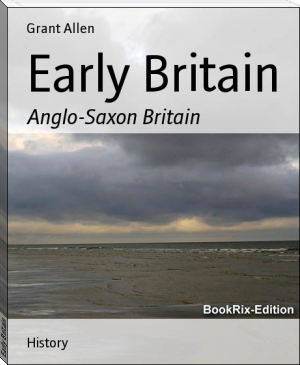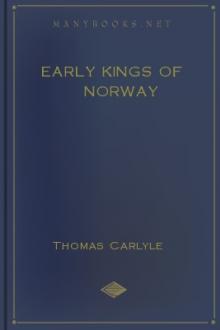Early Britain by Grant Allen (books recommended by bts TXT) 📕

- Author: Grant Allen
Book online «Early Britain by Grant Allen (books recommended by bts TXT) 📕». Author Grant Allen
Saxons, and accordingly these Teutonic pirates, of whatever race, were known as Saxons by the provincials, and all Englishmen are still so called by the modern Celts, in Wales, Scotland, and Ireland.
The outlying Roman provinces were close at hand, easy to reach, rich, ill-defended, and a tempting prey for the barbaric tribesmen of the north. Setting out in their light open skiffs from the islands at the mouth of the Elbe, or off the shore afterwards submerged in what is now the Zuyder Zee, the English or Saxon pirates crossed the sea with the prevalent north-east wind, and landed all along the provincial coasts of Gaul and Britain. As the empire decayed under the assaults of the Goths, their ravages turned into regular settlements. One great body pillaged, age after age, the neighbourhood of Bayeux, where, before the middle of the fifth century, it established a flourishing colony, and where the towns and villages all still bear names of Saxon origin. Another horde first plundered and then took up its abode near Boulogne, where local names of the English patronymic type also abound to the present day. In Britain itself, at a date not later than the end of the fourth century, we find (in the "Notitia Imperil") an officer who bears the title of Count of the Saxon Shore, and whose jurisdiction extended from Lincolnshire to Southampton Water. The title probably indicates that piratical incursions had already set in on Britain, and the duty of the count was most likely that of repelling the English invaders.
As soon as the Romans found themselves compelled to withdraw their garrison from Britain, leaving the provinces to defend themselves as best they might, the temptation to the English pirates became a thousand times stronger than before. Though the so-called history of the conquest, handed down to us by Bæda and the "English Chronicle,"[1] is now considered by many enquirers to be mythical in almost every particular, the facts themselves speak out for us with unhesitating certainty. We know that about the middle of the fifth century, shortly after the withdrawal of the regular Roman troops, several bodies of heathen Anglo-Saxons, belonging to the three tribes of Jutes, English, and Saxons, settled _en masse_ on the south-eastern shores of Britain, from the Firth of Forth to the Isle of Wight. The age of mere plundering descents was decisively over, and the age of settlement and colonisation had set in. These heathen Anglo-Saxons drove away, exterminated, or enslaved the Romanised and Christianised Celts, broke down every vestige of Roman civilisation, destroyed the churches, burnt the villas, laid waste many of the towns, and re-introduced a long period of pagan barbarism. For a while Britain remains enveloped in an age of complete uncertainty, and heathen myths intervene between the Christian historical period of the Romans and the Christian historical period initiated by the conversion of Kent. Of South-Eastern Britain under the pagan Anglo-Saxons we know practically nothing, save by inference and analogy, or by the scanty evidence of archæology.
[1] For an account of these two main authorities see further
on, Bæda in chapter xi., and the "Chronicle" in chapter
xviii.
According to tradition the Jutes came first. In 449, says the Celtic legend (the date is quite untrustworthy), they landed in Kent, where they first settled in Ruim, which we English call Thanet–then really an island, and gradually spread themselves over the mainland, capturing the great Roman fortress of Rochester and coast land as far as London. Though the details of this story are full of mythical absurdities, the analogy of the later Danish colonies gives it an air of great probability, as the Danes always settled first in islands or peninsulas, and thence proceeded to overrun, and finally to annex, the adjacent district. A second Jutish horde established itself in the Isle of Wight and on the opposite shore of Hampshire. But the whole share borne by the Jutes in the settlement of Britain seems to have been but small.
The Saxons came second in time, if we may believe the legends. In 477, Ælle, with his three sons, is said to have landed on the south coast, where he founded the colony of the South Saxons, or Sussex. In 495, Cerdic and Cynric led another kindred horde to the south-western shore, and made the first settlement of the West Saxons, or Wessex. Of the beginnings of the East Saxon community in Essex, and of the Middle Saxons in Middlesex, we know little, even by tradition. The Saxons undoubtedly came over in large numbers; but a considerable body of their fellow-tribesmen still remained upon the Continent, where they were still independent and unconverted up to the time of Karl the Great.
The English, on the other hand, apparently migrated in a body. There is no trace of any Englishmen in Denmark or Germany after the exodus to Britain. Their language, of which a dialect still survives in Friesland, has utterly died out in Sleswick. The English took for their share of Britain the nearest east coast. We have little record of their arrival, even in the legendary story; we merely learn that in 547, Ida "succeeded to the kingdom" of the Northumbrians, whence we may possibly conclude that the colony was already established. The English settlement extended from the Forth to Essex, and was subdivided into Bernicia, Deira, and East Anglia.
Wherever the Anglo-Saxons came, their first work was to stamp out with fire and sword every trace of the Roman civilisation. Modern investigations amongst pagan Anglo-Saxon barrows in Britain show the Low German race as pure barbarians, great at destruction, but incapable of constructive work. Professor Rolleston, who has opened several of these early heathen tombs of our Teutonic ancestors, finds in them everywhere abundant evidence of "their great aptness at destroying, and their great slowness in elaborating, material civilisation." Until the Anglo-Saxon received from the Continent the Christian religion and the Roman culture, he was a mere average Aryan barbarian, with a strong taste for war and plunder, but with small love for any of the arts of peace. Wherever else, in Gaul, Spain, or Italy, the Teutonic barbarians came in contact with the Roman civilisation, they received the religion of Christ, and the arts of the conquered people, during or before their conquest of the country. But in Britain the Teutonic invaders remained pagans long after their settlement in the island; and they utterly destroyed, in the south-eastern tract, almost every relic of the Roman rule and of the Christian faith. Hence we have here the curious fact that, during the fifth and sixth centuries, a belt of intrusive and aggressive heathendom intervenes between the Christians of the Continent and the Christian Welsh and Irish of western Britain. The Church of the Celtic Welsh was cut off for more than a hundred years from the Churches of the Roman world by a hostile and impassable barrier of heathen English, Jutes, and Saxons. Their separation produced many momentous effects on the after history both of the Welsh themselves and of their English conquerors.
CHAPTER IV.
THE COLONISATION OF THE COAST.
Though the myths which surround the arrival of the English in Britain have little historical value, they are yet interesting for the light which they throw incidentally upon the habits and modes of thought of the colonists. They have one character in common with all other legends, that they grow fuller and more circumstantial the further they proceed from the original time. Bæda, who wrote about A.D. 700, gives them in a very meagre form: the English Chronicle, compiled at the court of Ælfred, about A.D. 900, adds several important traditional particulars: while with the romantic Geoffrey of Monmouth, A.D. 1152, they assume the character of full and circumstantial tales. The less men knew about the conquest, the more they had to tell about it.
Among the most sacred animals of the Aryan race was the horse. Even in the Indian epics, the sacrifice of a horse was the highest rite of the primitive religion. Tacitus tells us that the Germans kept sacred white horses at the public expense, in the groves and woods of the gods: and that from their neighings and snortings, auguries were taken. Amongst the people of the northern marshlands, the white horse seems to have been held in especial honour, and to this day a white horse rampant forms the cognisance of Hanover and Brunswick. The English settlers brought this, their national emblem, with them to Britain, and cut its figure on the chalk downs as they advanced westward, to mark the progress of their conquest. The white horses on the Berkshire and Wiltshire hills still bear witness to their settlement. A white horse is even now the symbol of Kent. Hence it is not surprising to learn that in the legendary story of the first colonisation, the Jutish leaders who led the earliest Teutonic host into Thanet should bear the names of Hengest and Horsa, the stallion and the mare. They came in three keels–a ridiculously inadequate number, considering their size and the necessities of a conquering army: and they settled in 449 (for the legends are always most precise where they are least historical) in the Isle of Thanet. "A multitude of whelps," says the Welsh monk Gildas, "came forth from the lair of the barbaric lioness, in three cyuls, as they call them." Vortigern, King of the Welsh, had invited them to come to his aid against the Picts of North Britain and the Scots of Ireland, who were making piratical incursions into the deserted province, left unprotected through the heavy levies made by the departing Romans. The Jutes attacked and conquered the Gaels, but then turned against their Welsh allies.
In 455, the Jutes advanced from Thanet to conquer the whole of Kent, "and Hengest and Horsa fought with Vortigern the king," says the English Chronicle, "at the place that is cleped Æglesthrep; and there men slew Horsa his brother, and after that Hengest came to rule, and Æsc his son." One year later, Hengest and Æsc fought once more with the Welsh at Crayford, "and offslew 4,000 men; and the Britons then forsook Kent-land, and fled with mickle awe to London-bury." In this account we may see a dim recollection of the settlement of the two petty Jutish kingdoms in Kent, with their respective capitals at Canterbury and Rochester, whose separate dioceses still point back to the two original principalities. It may be worth while to note, too, that the name Æsc means the ash-tree; and that this tree was as sacred among plants as the horse was among animals.
Nevertheless, a kernel of truth doubtless lingers in the traditional story. Thanet was afterwards one of the first landing-places of the Danes: and its isolated position–for a broad belt of sea then separated the island from the Kentish main–would make it a natural post to be assigned by the Welsh to their doubtful piratical allies. The inlet was guarded by the great Roman fortress of Rhutupiæ: and after the fall of that important stronghold, the English may probably have occupied the principality of East Kent, with its capital of Canterbury. The walls of Rochester may have held out longer: and the West Kentish kingdom may well have been founded by two successful battles at the passage of the Medway and the Cray.
The legend as to the settlement of Sussex is of much the same sort. In 477, Ælle the Saxon came to Britain also with the suspiciously symmetrical number of three ships. With him came his three sons, Kymen, Wlencing, and Cissa. These names are obviously invented to account for those of three important places in the South-Saxon chieftainship. The host landed at Kymenes ora, probably Keynor, in the
The outlying Roman provinces were close at hand, easy to reach, rich, ill-defended, and a tempting prey for the barbaric tribesmen of the north. Setting out in their light open skiffs from the islands at the mouth of the Elbe, or off the shore afterwards submerged in what is now the Zuyder Zee, the English or Saxon pirates crossed the sea with the prevalent north-east wind, and landed all along the provincial coasts of Gaul and Britain. As the empire decayed under the assaults of the Goths, their ravages turned into regular settlements. One great body pillaged, age after age, the neighbourhood of Bayeux, where, before the middle of the fifth century, it established a flourishing colony, and where the towns and villages all still bear names of Saxon origin. Another horde first plundered and then took up its abode near Boulogne, where local names of the English patronymic type also abound to the present day. In Britain itself, at a date not later than the end of the fourth century, we find (in the "Notitia Imperil") an officer who bears the title of Count of the Saxon Shore, and whose jurisdiction extended from Lincolnshire to Southampton Water. The title probably indicates that piratical incursions had already set in on Britain, and the duty of the count was most likely that of repelling the English invaders.
As soon as the Romans found themselves compelled to withdraw their garrison from Britain, leaving the provinces to defend themselves as best they might, the temptation to the English pirates became a thousand times stronger than before. Though the so-called history of the conquest, handed down to us by Bæda and the "English Chronicle,"[1] is now considered by many enquirers to be mythical in almost every particular, the facts themselves speak out for us with unhesitating certainty. We know that about the middle of the fifth century, shortly after the withdrawal of the regular Roman troops, several bodies of heathen Anglo-Saxons, belonging to the three tribes of Jutes, English, and Saxons, settled _en masse_ on the south-eastern shores of Britain, from the Firth of Forth to the Isle of Wight. The age of mere plundering descents was decisively over, and the age of settlement and colonisation had set in. These heathen Anglo-Saxons drove away, exterminated, or enslaved the Romanised and Christianised Celts, broke down every vestige of Roman civilisation, destroyed the churches, burnt the villas, laid waste many of the towns, and re-introduced a long period of pagan barbarism. For a while Britain remains enveloped in an age of complete uncertainty, and heathen myths intervene between the Christian historical period of the Romans and the Christian historical period initiated by the conversion of Kent. Of South-Eastern Britain under the pagan Anglo-Saxons we know practically nothing, save by inference and analogy, or by the scanty evidence of archæology.
[1] For an account of these two main authorities see further
on, Bæda in chapter xi., and the "Chronicle" in chapter
xviii.
According to tradition the Jutes came first. In 449, says the Celtic legend (the date is quite untrustworthy), they landed in Kent, where they first settled in Ruim, which we English call Thanet–then really an island, and gradually spread themselves over the mainland, capturing the great Roman fortress of Rochester and coast land as far as London. Though the details of this story are full of mythical absurdities, the analogy of the later Danish colonies gives it an air of great probability, as the Danes always settled first in islands or peninsulas, and thence proceeded to overrun, and finally to annex, the adjacent district. A second Jutish horde established itself in the Isle of Wight and on the opposite shore of Hampshire. But the whole share borne by the Jutes in the settlement of Britain seems to have been but small.
The Saxons came second in time, if we may believe the legends. In 477, Ælle, with his three sons, is said to have landed on the south coast, where he founded the colony of the South Saxons, or Sussex. In 495, Cerdic and Cynric led another kindred horde to the south-western shore, and made the first settlement of the West Saxons, or Wessex. Of the beginnings of the East Saxon community in Essex, and of the Middle Saxons in Middlesex, we know little, even by tradition. The Saxons undoubtedly came over in large numbers; but a considerable body of their fellow-tribesmen still remained upon the Continent, where they were still independent and unconverted up to the time of Karl the Great.
The English, on the other hand, apparently migrated in a body. There is no trace of any Englishmen in Denmark or Germany after the exodus to Britain. Their language, of which a dialect still survives in Friesland, has utterly died out in Sleswick. The English took for their share of Britain the nearest east coast. We have little record of their arrival, even in the legendary story; we merely learn that in 547, Ida "succeeded to the kingdom" of the Northumbrians, whence we may possibly conclude that the colony was already established. The English settlement extended from the Forth to Essex, and was subdivided into Bernicia, Deira, and East Anglia.
Wherever the Anglo-Saxons came, their first work was to stamp out with fire and sword every trace of the Roman civilisation. Modern investigations amongst pagan Anglo-Saxon barrows in Britain show the Low German race as pure barbarians, great at destruction, but incapable of constructive work. Professor Rolleston, who has opened several of these early heathen tombs of our Teutonic ancestors, finds in them everywhere abundant evidence of "their great aptness at destroying, and their great slowness in elaborating, material civilisation." Until the Anglo-Saxon received from the Continent the Christian religion and the Roman culture, he was a mere average Aryan barbarian, with a strong taste for war and plunder, but with small love for any of the arts of peace. Wherever else, in Gaul, Spain, or Italy, the Teutonic barbarians came in contact with the Roman civilisation, they received the religion of Christ, and the arts of the conquered people, during or before their conquest of the country. But in Britain the Teutonic invaders remained pagans long after their settlement in the island; and they utterly destroyed, in the south-eastern tract, almost every relic of the Roman rule and of the Christian faith. Hence we have here the curious fact that, during the fifth and sixth centuries, a belt of intrusive and aggressive heathendom intervenes between the Christians of the Continent and the Christian Welsh and Irish of western Britain. The Church of the Celtic Welsh was cut off for more than a hundred years from the Churches of the Roman world by a hostile and impassable barrier of heathen English, Jutes, and Saxons. Their separation produced many momentous effects on the after history both of the Welsh themselves and of their English conquerors.
CHAPTER IV.
THE COLONISATION OF THE COAST.
Though the myths which surround the arrival of the English in Britain have little historical value, they are yet interesting for the light which they throw incidentally upon the habits and modes of thought of the colonists. They have one character in common with all other legends, that they grow fuller and more circumstantial the further they proceed from the original time. Bæda, who wrote about A.D. 700, gives them in a very meagre form: the English Chronicle, compiled at the court of Ælfred, about A.D. 900, adds several important traditional particulars: while with the romantic Geoffrey of Monmouth, A.D. 1152, they assume the character of full and circumstantial tales. The less men knew about the conquest, the more they had to tell about it.
Among the most sacred animals of the Aryan race was the horse. Even in the Indian epics, the sacrifice of a horse was the highest rite of the primitive religion. Tacitus tells us that the Germans kept sacred white horses at the public expense, in the groves and woods of the gods: and that from their neighings and snortings, auguries were taken. Amongst the people of the northern marshlands, the white horse seems to have been held in especial honour, and to this day a white horse rampant forms the cognisance of Hanover and Brunswick. The English settlers brought this, their national emblem, with them to Britain, and cut its figure on the chalk downs as they advanced westward, to mark the progress of their conquest. The white horses on the Berkshire and Wiltshire hills still bear witness to their settlement. A white horse is even now the symbol of Kent. Hence it is not surprising to learn that in the legendary story of the first colonisation, the Jutish leaders who led the earliest Teutonic host into Thanet should bear the names of Hengest and Horsa, the stallion and the mare. They came in three keels–a ridiculously inadequate number, considering their size and the necessities of a conquering army: and they settled in 449 (for the legends are always most precise where they are least historical) in the Isle of Thanet. "A multitude of whelps," says the Welsh monk Gildas, "came forth from the lair of the barbaric lioness, in three cyuls, as they call them." Vortigern, King of the Welsh, had invited them to come to his aid against the Picts of North Britain and the Scots of Ireland, who were making piratical incursions into the deserted province, left unprotected through the heavy levies made by the departing Romans. The Jutes attacked and conquered the Gaels, but then turned against their Welsh allies.
In 455, the Jutes advanced from Thanet to conquer the whole of Kent, "and Hengest and Horsa fought with Vortigern the king," says the English Chronicle, "at the place that is cleped Æglesthrep; and there men slew Horsa his brother, and after that Hengest came to rule, and Æsc his son." One year later, Hengest and Æsc fought once more with the Welsh at Crayford, "and offslew 4,000 men; and the Britons then forsook Kent-land, and fled with mickle awe to London-bury." In this account we may see a dim recollection of the settlement of the two petty Jutish kingdoms in Kent, with their respective capitals at Canterbury and Rochester, whose separate dioceses still point back to the two original principalities. It may be worth while to note, too, that the name Æsc means the ash-tree; and that this tree was as sacred among plants as the horse was among animals.
Nevertheless, a kernel of truth doubtless lingers in the traditional story. Thanet was afterwards one of the first landing-places of the Danes: and its isolated position–for a broad belt of sea then separated the island from the Kentish main–would make it a natural post to be assigned by the Welsh to their doubtful piratical allies. The inlet was guarded by the great Roman fortress of Rhutupiæ: and after the fall of that important stronghold, the English may probably have occupied the principality of East Kent, with its capital of Canterbury. The walls of Rochester may have held out longer: and the West Kentish kingdom may well have been founded by two successful battles at the passage of the Medway and the Cray.
The legend as to the settlement of Sussex is of much the same sort. In 477, Ælle the Saxon came to Britain also with the suspiciously symmetrical number of three ships. With him came his three sons, Kymen, Wlencing, and Cissa. These names are obviously invented to account for those of three important places in the South-Saxon chieftainship. The host landed at Kymenes ora, probably Keynor, in the
Free e-book «Early Britain by Grant Allen (books recommended by bts TXT) 📕» - read online now
Similar e-books:





Comments (0)